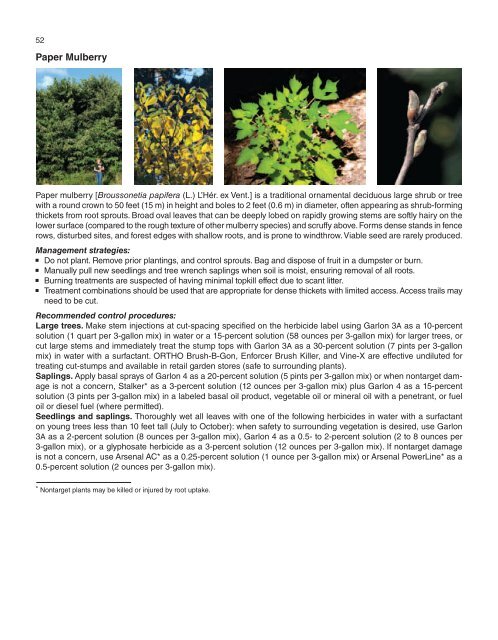A Management Guide for Invasive Plants in Southern Forests James ...
A Management Guide for Invasive Plants in Southern Forests James ...
A Management Guide for Invasive Plants in Southern Forests James ...
- No tags were found...
Create successful ePaper yourself
Turn your PDF publications into a flip-book with our unique Google optimized e-Paper software.
52Paper MulberryPaper mulberry [Broussonetia papifera (L.) L’Hér. ex Vent.] is a traditional ornamental deciduous large shrub or treewith a round crown to 50 feet (15 m) <strong>in</strong> height and boles to 2 feet (0.6 m) <strong>in</strong> diameter, often appear<strong>in</strong>g as shrub-<strong>for</strong>m<strong>in</strong>gthickets from root sprouts. Broad oval leaves that can be deeply lobed on rapidly grow<strong>in</strong>g stems are softly hairy on thelower surface (compared to the rough texture of other mulberry species) and scruffy above. Forms dense stands <strong>in</strong> fencerows, disturbed sites, and <strong>for</strong>est edges with shallow roots, and is prone to w<strong>in</strong>dthrow. Viable seed are rarely produced.<strong>Management</strong> strategies:Do not plant. Remove prior plant<strong>in</strong>gs, and control sprouts. Bag and dispose of fruit <strong>in</strong> a dumpster or burn.Manually pull new seedl<strong>in</strong>gs and tree wrench sapl<strong>in</strong>gs when soil is moist, ensur<strong>in</strong>g removal of all roots.Burn<strong>in</strong>g treatments are suspected of hav<strong>in</strong>g m<strong>in</strong>imal topkill effect due to scant litter.Treatment comb<strong>in</strong>ations should be used that are appropriate <strong>for</strong> dense thickets with limited access. Access trails mayneed to be cut.Recommended control procedures:Large trees. Make stem <strong>in</strong>jections at cut-spac<strong>in</strong>g specified on the herbicide label us<strong>in</strong>g Garlon 3A as a 10-percentsolution (1 quart per 3-gallon mix) <strong>in</strong> water or a 15-percent solution (58 ounces per 3-gallon mix) <strong>for</strong> larger trees, orcut large stems and immediately treat the stump tops with Garlon 3A as a 30-percent solution (7 p<strong>in</strong>ts per 3-gallonmix) <strong>in</strong> water with a surfactant. ORTHO Brush-B-Gon, En<strong>for</strong>cer Brush Killer, and V<strong>in</strong>e-X are effective undiluted <strong>for</strong>treat<strong>in</strong>g cut-stumps and available <strong>in</strong> retail garden stores (safe to surround<strong>in</strong>g plants).Sapl<strong>in</strong>gs. Apply basal sprays of Garlon 4 as a 20-percent solution (5 p<strong>in</strong>ts per 3-gallon mix) or when nontarget damageis not a concern, Stalker* as a 3-percent solution (12 ounces per 3-gallon mix) plus Garlon 4 as a 15-percentsolution (3 p<strong>in</strong>ts per 3-gallon mix) <strong>in</strong> a labeled basal oil product, vegetable oil or m<strong>in</strong>eral oil with a penetrant, or fueloil or diesel fuel (where permitted).Seedl<strong>in</strong>gs and sapl<strong>in</strong>gs. Thoroughly wet all leaves with one of the follow<strong>in</strong>g herbicides <strong>in</strong> water with a surfactanton young trees less than 10 feet tall (July to October): when safety to surround<strong>in</strong>g vegetation is desired, use Garlon3A as a 2-percent solution (8 ounces per 3-gallon mix), Garlon 4 as a 0.5- to 2-percent solution (2 to 8 ounces per3-gallon mix), or a glyphosate herbicide as a 3-percent solution (12 ounces per 3-gallon mix). If nontarget damageis not a concern, use Arsenal AC* as a 0.25-percent solution (1 ounce per 3-gallon mix) or Arsenal PowerL<strong>in</strong>e* as a0.5-percent solution (2 ounces per 3-gallon mix).* Nontarget plants may be killed or <strong>in</strong>jured by root uptake.
















